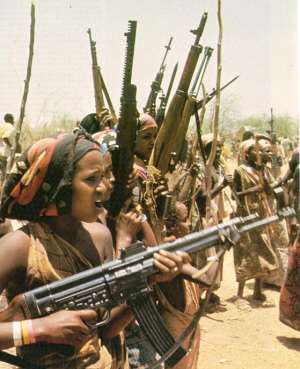
The Somali people have a long and rich history, with a culture that is deeply rooted in their ancestral land. However, in the 20th century, Somali communities were divided into different countries, often against their will. One such example was the Somali people who were living under the Derg regime in Ethiopia, where they were subjected to various forms of oppression.
The Derg regime, led by Mengistu Haile Mariam, was a military junta that ruled Ethiopia from 1974 to 1987. During this period, the regime launched a brutal campaign against the Somali community in Ethiopia, which included mass detentions, torture, and extrajudicial killings. The Somali people in Ethiopia were denied their basic human rights, including the right to self-determination, and were forced to assimilate into the dominant Ethiopian culture.
In response to this oppression, the Western Somali Liberation Movement was formed in an effort to free Somalis in Ethiopia from their plight. The movement was led by a group of Somali nationalists who believed that the only way to achieve their goals was through armed struggle. In 1977, the Western Somali Liberation Front (WSLF) launched a full-scale invasion of Ethiopia, which resulted in the Ogaden War.
The Ogaden War was a brutal conflict that lasted from 1977 to 1978. The Western Somali Liberation Front was initially successful in its operations, capturing large swathes of territory from the Ethiopian army. However, this changed when Cuban and Soviet forces intervened on behalf of the Ethiopian government. The Ethiopian army, with the help of its allies, was able to turn the tide of the war, and ultimately emerged victorious.
Despite this outcome, Ethiopian chauvinists like to proclaim that the Somali liberation fighters were defeated by Ethiopian heroes, when in fact it was the intervention of the Cuban and Soviet forces that turned the tide of the war. The Cuban and Soviet forces provided the Ethiopian army with much-needed military support, including weapons, ammunition, and training.
The defeat of the Somali liberation fighters was a significant setback for the Somali community, both in Ethiopia and in Somalia. The war resulted in the displacement of thousands of Somali people, and many lost their lives. The defeat also highlighted the need for the Somali community to unite and work towards their common goals.
The defeat of the Somalis in 1977 is a reminder of the complex geopolitical dynamics that shape conflicts in the Horn of Africa. The Ogaden War was not simply a struggle between the Somali and Ethiopian people, but it was also a proxy war between the Soviet Union and the United States, who were competing for influence in the region.
The involvement of foreign powers in the conflict complicated the situation, and ultimately resulted in the defeat of the Somali liberation fighters. The role of Cuba and the Soviet Union in the conflict also highlights the challenges that African liberation movements faced in their struggle for independence. While foreign support was often crucial in the fight against colonialism, it also came with its own set of challenges and limitations.
In conclusion, the defeat of the Somali liberation fighters in the 1977 Ogaden War was achieved through Cuba and Soviet Union internvention. While the defeat of the Somali liberation fighters was a setback, but the legacy of the Somali Liberation Movement lives on, and the struggle for self-determination and freedom continues. The wounds of the past may still be felt, but the Somali people remain resilient and hopeful for a better future.




 Minority will expose the beneficial owners of SML, recover funds paid to company...
Minority will expose the beneficial owners of SML, recover funds paid to company...
 Prof. Opoku-Agyemang has ‘decapitated’ the NPP’s strategies; don’t take them ser...
Prof. Opoku-Agyemang has ‘decapitated’ the NPP’s strategies; don’t take them ser...
 Abubakar Tahiru: Ghanaian environmental activist sets world record by hugging 1,...
Abubakar Tahiru: Ghanaian environmental activist sets world record by hugging 1,...
 Prof. Naana Opoku-Agyemang will serve you with dignity, courage, and integrity a...
Prof. Naana Opoku-Agyemang will serve you with dignity, courage, and integrity a...
 Rectify salary anomalies to reduce tension and possible strike action in public ...
Rectify salary anomalies to reduce tension and possible strike action in public ...
 Stop all projects and fix ‘dumsor’ — Professor Charles Marfo to Akufo-Addo
Stop all projects and fix ‘dumsor’ — Professor Charles Marfo to Akufo-Addo
 Blue and white painted schools will attract dirt shortly – Kofi Asare
Blue and white painted schools will attract dirt shortly – Kofi Asare
 I endorse cost-sharing for free SHS, we should prioritise to know who can pay - ...
I endorse cost-sharing for free SHS, we should prioritise to know who can pay - ...
 See the four arsonists who petrol-bombed Labone-based CMG
See the four arsonists who petrol-bombed Labone-based CMG
 Mahama coming back because Akufo-Addo has failed, he hasn't performed more than ...
Mahama coming back because Akufo-Addo has failed, he hasn't performed more than ...
